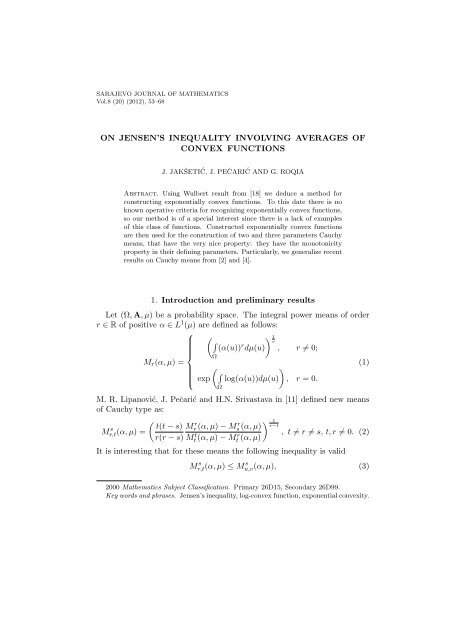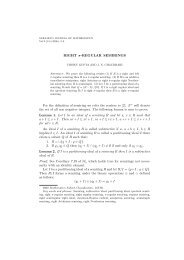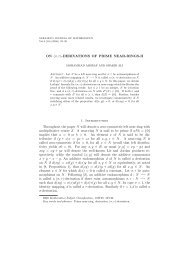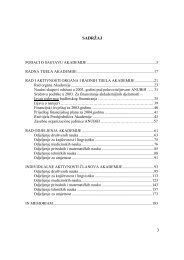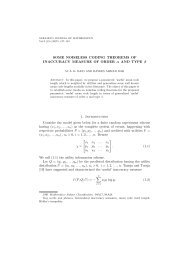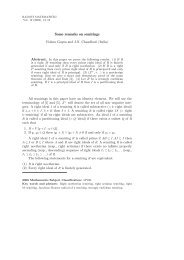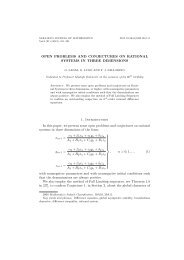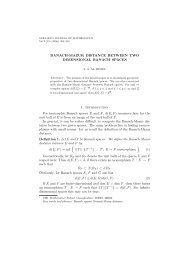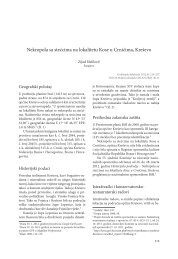ON JENSEN'S INEQUALITY INVOLVING AVERAGES OF ... - anubih
ON JENSEN'S INEQUALITY INVOLVING AVERAGES OF ... - anubih
ON JENSEN'S INEQUALITY INVOLVING AVERAGES OF ... - anubih
You also want an ePaper? Increase the reach of your titles
YUMPU automatically turns print PDFs into web optimized ePapers that Google loves.
54 J. JAKŠETIĆ, J. PEČARIĆ AND G. ROQIAfor r, t, u, v, s ∈ R such that r ≤ u, t ≤ v. All limiting cases of (2) and theproof of (3) can be found in [2]. Moreover, some related results of this typeare previously obtained in [8] and [12]. It is interesting that one year laterin the paper [16] the case s = 0 of this mean as an extension of Stolarskymeans is considered without mentioning reference [2] ( see (2.2) in [16] ).Also, in [16] there is no mention of any results from [8, 11, 12] (see Theorem4.1 in [16] and compare it with results from [8, 11, 12] ).D. E. Wulbert in, [18] proved that for a convex function ψ : I → R,⎧⎪⎨F (a, b) =⎪⎩∫1bb−aψ(x)dx, a ≠ b;aψ(a), a = b.is convex on I × I.In [4], D. E. Wulbert’s result is given in the following form:Theorem 1.1. Let ψ be a continuous function on an interval I with anonempty interior. If ψ is convex on I, then the integral arithmetic meanF defined in (4) is convex on I 2 .Furthermore, for a i , b i ∈ I, i = 1, . . . , n and non-negative real weightsw i , i = 1, . . . , n such that ∑ ni=1 w i = 1, the following holds(4)1b − a∫ baψ(x)dx ≤n∑i=1w i1b i − a i∫ bia iψ(x)dx (5)and(ā ) + ¯bψ ≤ 12 ¯b − ā∫ā¯bψ(t)dt≤n∑i=1where ā = ∑ ni=1 w ia i , ¯b = ∑ ni=1 w ib i .w i1b i − a i∫b ia iψ(t)dt≤n∑i=1w iψ(a i ) + ψ(b i )2(6)Using Theorem 1.1, we gave a discrete extension of means (2) and we getnew means of Cauchy type defined by :⎡Mr,t(w s i , a s i , b s i ; n)= ⎢t 3 −ts 2⎣r 3 − rs 2n∑aw r+si −b r+si i a s ii=1−bs in∑aw t+si −b t+si i a s ii=1−bs i⎤− (M w s i(a i )) r+s −(Mw s i(b i )) r+s(Mw s i(a i )) s −(Mw s i(b i )) s⎥− (M w s i(a i )) t+s −(Mw s i(b i )) t+s ⎦(Mw s i(a i )) s −(Mw s i(b i )) s1r−t
<strong>ON</strong> JENSEN’S <strong>INEQUALITY</strong> <strong>INVOLVING</strong> <strong>AVERAGES</strong> <strong>OF</strong> C<strong>ON</strong>VEX FUNCTI<strong>ON</strong>S 55where⎧( n∑⎪⎨ w i x SMw S ii(x i ) = i=1n∏ ⎪⎩i=1) 1S, S ≠ 0,x w ii, S = 0,r ≠ t ≠ s, r ≠ s, −s, s ≠ 0.Limiting cases are also derived and we have shown that these means aremonotonic, that is for r, t, u, v, s ∈ R such that r ≤ u, t ≤ vM s r,t(w i ; a i , b i ; n) ≤ M s u,v(w i ; a i , b i ; n). (7)If we let a i → b i , i = 1, . . . , n, we have discrete version of means in (2). Letus note that the case s = 0 is also considered in [16] (see (1.14) and (1.15)in [16]).In this paper, we will give further extension of results from [10]. To beginwith, let us note that the following integral version of (5) is valid:Theorem 1.2. Let α, β : Ω → I (I, an interval with non-empty interior)be functions from L 1 (µ) and let ψ : I → R be a continuous convex function.Then the following inequality is valid:1β − α∫ βα∫ψ(x)dx ≤Ω(1β(u) − α(u)where α = ∫ α(u)dµ(u), β = ∫ β(u)dµ(u).ΩΩ∫ β(u)α(u)ψ(x)dx)dµ(u), (8)Proof. Follows from integral version of convexity on I × I (see [9], p. 51),and the fact that the function F : I × I → R defined with (4) is convex. □In the later text J stands for an open interval in R; with R + we denotepositive reals.Definition 1. A function f : J → R + is a log-convex in Jensen’s sense if( ) x + yf 2 ≤ f(x)f(y),2for all x, y ∈ J.The following simple result gives us necessary and sufficient condition torecognize log-convex function in Jensen’s sense.Lemma 1.3. A function f : J → R + is a log-convex in Jensen’s sense ifand only if( ) x + yu 2 1f(x) + 2u 1 u 2 f + u 222f(y)) ≥ 0, (9)for all u 1 , u 2 ∈ R and x, y ∈ J.
56 J. JAKŠETIĆ, J. PEČARIĆ AND G. ROQIANow we define exponentially convex functions (see [1]).Definition 2. A function f : J → R is exponentially convex on J if it iscontinuous andn∑ξ i ξ j f (x i + x j ) ≥ 0i,j=1for all n ∈ N and all choices ξ i ∈ R, i = 1, . . . , n such that x i + x j ∈ J, 1 ≤i, j ≤ n.For our purposes we will need the following simple characterization ofexponential convexity.Proposition 1.4. Let f : J → R. The following propositions are equivalent.(i) fis exponentially convex.(ii) f is continuous andn∑ξ i ξ j fi,j=1( )xi + x j≥ 0,2for all n ∈ N, ξ i ∈ R and x i ∈ J, i = 1, . . . , n.The following corollary gives the inclusion relation between two very importantsubclasses of the class of convex functions.Corollary 1.5. A positive exponentially convex function f : J → R + islog-convex function i.e. log f is convex function on J.Exponentially convex functions have strong analytical properties: theyare differentiable of all orders, and even more, they are analytical (see [3,5]). Previous results follow from the integral representation of exponentiallyconvex functions:Theorem 1.6. The function f : J → R is exponentially convex on J if andonly iff(x) =∫ ∞−∞for some non-decreasing function σ : R → R.Proof. See [1], p. 211.e tx dσ(t), x ∈ J (10)Remark 1.7. Theorem 1.6 enables us, in particular, to conclude that anyreal function that is a Laplace transform of some positive function is anexponentially convex function on its open domain.The next theorem from [7] will be very helpful in the sequel.□
<strong>ON</strong> JENSEN’S <strong>INEQUALITY</strong> <strong>INVOLVING</strong> <strong>AVERAGES</strong> <strong>OF</strong> C<strong>ON</strong>VEX FUNCTI<strong>ON</strong>S 57Theorem 1.8. Let f : J → R + be log-convex, derivable function.Let M : J × J → R + be defined by⎧( ) 1⎨ f(x) x−yM(x, y) =f(y), x ≠ y;)⎩exp , x = y.If x 1 ≤ x 2 , y 1 ≤ y 2 then(f ′ (x)f(x)(11)M(x 1 , y 1 ) ≤ M(x 2 , y 2 ). (12)It is well known that a real valued convex function ψ defined on I ischaracterized by the second order divided difference at mutually distinctpoints x 0 , x 1 , x 2 ∈ I:ψ(x 0 )[x 0 , x 1 , x 2 ; ψ] =(x 0 − x 1 )(x 0 − x 2 )ψ(x 1 )+(x 1 − x 0 )(x 1 − x 2 ) + ψ(x 2 )(x 2 − x 0 )(x 2 − x 1 ) ≥ 0,If ψ is a differentiable function, we have the support line convexity criteriafor x 0 , x 1 ∈ I[x 0 , x 0 , x 1 ; ψ] = ψ(x 1) − ψ(x 0 ) − (x 1 − x 0 )ψ ′ (x 0 )(x 1 − x 0 ) 2 ≥ 0.Also, if ψ is twice differentiable on I, we have a very useful result aboutconvexity for x 0 ∈ I[x 0 , x 0 , x 0 ; ψ] = ψ′′ (x 0 )22. Main results≥ 0.Let I be an interval with nonempty interior and J stand for an open intervalin R. Let α, β : Ω → I be functions from L 1 (µ) as in introduction and letψ : I → R be a continuous function.Denote∫F (α, β; ψ; µ) =Ω(1β(u) − α(u)∫ β(u)α(u)ψ(x)dx)dµ(u) − 1 ∫ βψ(x)dx,β − α α(13)where α = ∫ α(u)dµ(u), β = ∫ β(u)dµ(u). From Theorem 1.2 it follows thatΩΩif ψ is convex function, then F (α, β; ψ; µ) ≥ 0.Further, we introduce the following families of functions:
58 J. JAKŠETIĆ, J. PEČARIĆ AND G. ROQIA• X 1 = {ψ t : I → R, t ∈ J}, a family of functions from C(I) suchthat t → [x 0 , x 1 , x 2 ; ψ t ] is log-convex in Jensen’s sense on J for everychoice of distinct points x 0 , x 1 , x 2 ∈ I;• X 2 = {ψ t : I → R, t ∈ J}, a family of differentiable functions on Isuch that t → [x 0 , x 0 , x 1 ; ψ t ] is log-convex in Jensen’s sense on J forevery choice of distinct points x 0 , x 1 ∈ I;• X 3 = {ψ t : I → R, t ∈ J}, a family of twice differentiable functionsfrom I such that t → [x 0 , x 0 , x 0 ; ψ t ] is log-convex in Jensen’s senseon J for every choice of x 0 ∈ I.Theorem 2.1. Let (Ω, A, µ) be a probability space, let α, β : Ω → I befunctions from L 1 (µ). Let F : J → R be function defined byF (t) = F (α, β; ψ t ; µ) (14)ψ t ∈ X k , t ∈ J; k = 1, 2, 3. Then the following is valid(i) the function F is log-convex in Jensen’s sense on J;(ii) if the function F is continuous, it is log-convex and for r, s, t ∈ Jsuch that r < s < t we have,(F (s)) t−r ≤ (F (r)) t−s (F (t)) s−r ; (15)(iii) if the function F is derivable, then for every t, r, u, v ∈ J such thatr ≤ u, t ≤ v, we haveM r,t (α, β, µ) ≤ M u,v (α, β, µ), (16)where⎧⎨( ) 1F (r) r−tM r,t (α, β, µ) = F (t), t ≠ r;⎩exp ( ddr log F (r)) , t = r.(17)Proof.(i) Let u 1 , u 2 ∈ R and t, r ∈ J be arbitrary. Define function h on I byh(x) = u 2 1ψ t (x) + 2u 1 u 2 ψ t+r (x) + u 2 2ψ r (x).2Then][x 0 , x 1 , x 2 ; h] = u 2 1 [x 0 , x 1 , x 2 ; ψ t ] + 2u 1 u 2[x 0 , x 1 , x 2 ; ψ t+r2+ u 2 2 [x 0 , x 1 , x 2 ; ψ r ]Since t → [x 0 , x 1 , x 2 ; ψ t ] is log-convex in Jensen’s sense on J[x 0 , x 1 , x 2 ; h] ≥ 0
<strong>ON</strong> JENSEN’S <strong>INEQUALITY</strong> <strong>INVOLVING</strong> <strong>AVERAGES</strong> <strong>OF</strong> C<strong>ON</strong>VEX FUNCTI<strong>ON</strong>S 59we conclude that h is convex function on I. Hence (8) gives( ) t + ru 2 1F (t) + 2u 1 u 2 F + u 222F (r) ≥ 0F is log-convex in the Jensen’s sense.(ii) Since F is continuous on J it is a log-convex function.(iii) This is a simple consequence of Theorem 1.8.Remark 2.2. The case X 3 of the Theorem 2.1 is a generalization of Theorem4.2 in [16]. It is interesting to note here that the author S. Simić hasproved exactly the same theorem twice: once as Theorem 4.2 in [16] and thesecond time as Theorem 1 in [17], but there is no reference to either.We now go a step further as we prove analogue of Theorem 2.1 for exponentiallyconvex functions. We first introduce the following families offunctions:• X 1 = {ψ t : I → R, t ∈ J}, a family of functions from C(I) suchthat t → [x 0 , x 1 , x 2 ; ψ t ] is an exponentially convex function on J forevery choice of 3 distinct points x 0 , x 1 , x 2 ∈ I;• X 2 = {ψ t : I → R, t ∈ J}, a family of differentiable functions on Isuch that t → [x 0 , x 0 , x 1 ; ψ t ] is an exponentially convex function onJ for every choice of 2 distinct points x 0 , x 1 ∈ I;• X 3 = {ψ t : I → R, t ∈ J}, a family of twice differentiable functionsfrom I such that t → [x 0 , x 0 , x 0 ; ψ t ] is an exponentially convexfunction on J for every choice of x 0 ∈ I.Theorem 2.3. Let (Ω, A, µ) be a probability space, let I be an interval inR with a nonempty interior and let α, β : Ω → I be functions from L 1 (µ).Let F : J → R be function defined byF (t) = F (α, β; ψ t ; µ), (18)ψ t ∈ X k , t ∈ J; k = 1, 2, 3. Then the following hold(i) the function F is exponentially convex on J;(ii) for each n ∈ N and t 1 , . . . , t n ∈ J the matrixpositive semi-definite. Particularly,[ (ti + t jdet F2)] ni,j=1≥ 0;[F(iii) for every t, r, u, v ∈ J such that r ≤ u, t ≤ v we have□( )]ti +t n j2isi,j=1M r,t (α, β, µ) ≤ M u,v (α, β, µ), (19)
60 J. JAKŠETIĆ, J. PEČARIĆ AND G. ROQIAwhere⎧⎨( ) 1F (r) r−tM r,t (α, β, µ) =, r ≠ t;F (t)⎩exp ( ddr log F (r)) , t = r.(20)Proof. (i) Let u i ∈ R, t i ∈ J, i = 1, . . . , n, for arbitrary fixed n ∈ N. Definea function ν on I byn∑ν(x) = u i u j ψ t i +t j (x). (21)2By assumption[x 0 , x 1 , x 2 ; ν] =i,j=1n∑i,j=1[]x 0 , x 1 , x 2 ; ψ t i +t j ≥ 0,2hence ν is convex function on I. Now we can substitute ψ = ν in (8), andwe getn∑( )ti + t ju i u j F ≥ 02i,j=1concluding exponential convexity of F on J.(ii) and (iii)-parts are simple consequences of (i).Now we need to built mean value theorems in order to generate Cauchytype means.Theorem 2.4. Let (Ω, A, µ) be a probability space, let I be a compact intervalin R, and let α, β : Ω → I be functions from L 1 (µ) and let f ∈ C 2 (I).Then there exists ξ ∈ I such thatF (α, β; f; µ) = f ′′ (ξ)F (α, β; e 2 ; µ) (22)2where F is defined with (13) and e 2 (x) = x 2 .Proof. Analogous to the proof of Theorem 2.4 in [10].Following the steps of the proof of Theorem 2.5 in [10] , we can prove thefollowing mean value theorem.Theorem 2.5. Let (Ω, A, µ) be a probability space, I be a compact intervalin R, let α, β : Ω → I be functions from L 1 (µ) and let f 1 , f 2 ∈ C 2 (I). Thenthere exits ξ ∈ I such thatf ′′1 (ξ)f ′′2 (ξ) = F (α, β; f 1, µ)F (α, β; f 2 ; µ) , (23)□□
<strong>ON</strong> JENSEN’S <strong>INEQUALITY</strong> <strong>INVOLVING</strong> <strong>AVERAGES</strong> <strong>OF</strong> C<strong>ON</strong>VEX FUNCTI<strong>ON</strong>S 61assuming both denominators are non-zero.Remark 2.6. The previous Theorem is a generalization of results in [8, 11,12].Remark 2.7. Theorem (2.5) enables us to define various types of means,because if the function f 1′′has inverse from (23) we havef 2′′( ) f′′ −1 ( )1 F (α, β; f1 , µ)ξ =f 2′′.F (α, β; f 2 ; µ)The number ξ ∈ I we call Cauchy mean on I.3. ExamplesExample 3.1. Suppose that I is any compact interval in R + , J = R + andthat {ψ t : I → R, t ∈ J} is the family of functions from C 2 (I) defined byψ t (x) = e−x√ t.tSince t ↦→ d2 ψ t(x) = e −x√t , is exponentially convex on J by Example 3 indx 2[7] (see [15] p. 214), by Theorem 2.3 we conclude the exponential convexityof function F on J, whereF (t) =⎛−1 ∫( √ ⎝t) 3Ωe −√ tβ(u) − e −√ tα(u)β(u) − α(u)If we apply (20) on F we get expressions Mr,t(α, 1 β; µ) :⎧⎪⎨Mr,t(α, 1 β; µ) =⎪⎩⎞dµ(u) − e−β√t − e −α√ t⎠ . (24)β − α( ) 1F (α,β;ψr;µ) r−tF (α,β;ψ t ;µ)), r ≠ t;()exp − 1 r − F (α,β;id·ψ r;µ)2 √ rF (α,β;ψ r;µ), r = t,and we have the monotonicity property (19): for (r, t), (u, v) ∈ J × J suchthat r ≤ u, t ≤ vM 1 r,t(α, β; µ) ≤ M 1 u,v(α, β; µ). (25)Example 3.2. Suppose that I is a compact interval in R + and J = R + .Define ψ t ∈ X 3 by{t −x, t ≠ 1;ψ t (x) =(log t) 2x 22 , t = 1.
62 J. JAKŠETIĆ, J. PEČARIĆ AND G. ROQIAExponential convexity of t ↦→ d2dx 2 ψ t (x) = t −x on J for x ∈ R + is given byExample 2 in [7] (see also [15], p. 210). For this family the exponentiallyconvex function is:⎧⎪⎨F (t) =⎪⎩[−1 ∫log 3 tΩ[1 ∫6Ω]t −β(u) −t −α(u)β(u)−α(u)dµ(u) − t−β −t −α, t ≠ 1;β−α]β 3 (u)−α 3 (u)β(u)−α(u) dµ(u) − β3 −α 3, t = 1.β−α(26)Then, as corresponding to (20), we define⎧⎪⎨Mr,t(α, 2 β; µ) =⎪⎩[ ] 1F (α,β;ψr ;µ) r−tF (α,β;ψ t ;µ), r ≠ t;[]exp − F (α,β;idψ r;µ)r F (α,β;ψ r ;µ) − 2r log r, r = t, r ≠ 1;[exp− F (α,β;id·ψ 1;µ)3F (α,β;ψ 1 ;µ)], r = t, t = 1.Again, we have the monotonicity property (19):If (r, t), (u, v) ∈ J × J such that r ≤ u, t ≤ v, thenM 2 r,t(α, β; µ) ≤ M 2 u,v(α, β; µ). (27)Example 3.3. Define a family of functions {ψ t : t ∈ J}, on I ⊆ R, I =[a, b], J = R by{ 1eψ t (x) =tx , t ≠ 0;t12 2 x2 , t = 0,(28)Then t ↦→ d2dx 2 (ψ t (x)) = e tx which is a basic example of exponentially convexfunction on R for each x ∈ [a, b]. Using Theorem 2.3, for this family we canconstruct a new exponentially convex function defined by⎧⎪⎨F (t) =⎪⎩1t 3 [ ∫Ω[1 ∫6Ω]e tβ(u) −e tα(u)β(u)−α(u)dµ(u) − etβ −e tα, t ≠ 0;β−α]β 3 (u)−α 3 (u)β(u)−α(u) dµ(u) − β3 −α 3, t = 0.β−α(29)
<strong>ON</strong> JENSEN’S <strong>INEQUALITY</strong> <strong>INVOLVING</strong> <strong>AVERAGES</strong> <strong>OF</strong> C<strong>ON</strong>VEX FUNCTI<strong>ON</strong>S 63Using (20) we now construct M 3 r,t(α, β; µ) on R × R⎧⎪⎨Mr,t(α, 3 β; µ) =⎪⎩[ ] 1F (α,β;ψr ;µ) r−tF (α,β;ψ t ;µ), r ≠ t;[ ]exp F (α,β;id·ψr;µ)F (α,β;ψ r;µ)− 2 r, r = t ≠ 0;exp[ ]F (α,β;id·ψ0 ;µ)3F (α,β;ψ 0 );µ, r = t = 0.(30)Again we have monotonicityM 3 r,t(α, β; µ) ≤ M 3 u,v(α, β; µ), r ≤ u, t ≤ v. (31)Observe here, that, according Theorem 2.5, we have here Cauchy means:e ξ =[ ] 1F (α, β; ψr ; µ) r−t, (32)F (α, β; ψ t ; µ)for some(unique) ξ ∈ I = [a, b]. So we conclude that M 3 r,t(α, β; µ) representsa Cauchy mean on [e a , e b ].Remark 3.4.(i) If we replace α → log α and β → log β in (30) we get the continuousversion of the 3-parameters mean for s = 0 obtained in [4].(ii) The case α = β on Ω, gives us the limiting cases of the new Cauchymeans for s = 0 in [2], that are means from [16].Example 3.5. Define a family of functions Φ = {ϕ t : t ∈ J}, on I ⊆ R + ,I = [a, b], J = R, by⎧x⎨tt(t−1), t ≠ 1, 0;ϕ t (x) =⎩− log x, t = 0;x log x, t = 1.(33)Then t ↦→ d2dx 2 (ϕ t (x)) = x t−2 is again an exponentially convex function on Jsince x t−2 = e (t−2) log x . Using Theorem 2.3, for this family construct a new
64 J. JAKŠETIĆ, J. PEČARIĆ AND G. ROQIAexponentially convex function defined by⎧ [1 ∫t 3 −tΩ⎪⎨F (t) =[1 ∫2Ωβ t+1 (u)−α t+1 (u)β(u)−α(u)dµ(u) − βt+1 −α t+1β−α], t ≠ −1, 0, 1;]log(β(u))−log(α(u))β(u)−α(u)dµ(u) − log(β)−log(α) , t = −1;β−αβ log β−α log αβ−α− ∫ Ωβ(u) log β(u)−α(u) log α(u)β(u)−α(u)dµ(u), t = 0;⎪⎩∫Ωβ(u) 2 log β(u)−α(u) 2 log α(u)β(u)−α(u)dµ(u) − β2 log β−α 2 log α, t = 1β−αUsing (20), for family Φ we now construct M 4 r,t(α, β; µ; Φ) on R × R :⎧⎪⎨Mr,t(α, 4 β; µ; Φ) =⎪⎩[ ] 1F (α,β;ϕr;µ) r−tF (α,β;ϕ[ t;µ)exp 1−2r[exp 1 − F (α,β;ϕ2 0 ;µ)[expr 2 −r − F (α,β;ϕ 0ϕ r ;µ)F (α,β;ϕ r ;µ)2F (α,β;ϕ 0 ;µ)−1 − F (α,β;ϕ 0ϕ 1 ;µ)2F (α,β;ϕ 1 ;µ)M 4 r,t(α, β; µ; Φ) are Cauchy means since, for r ≠ t,, r ≠ t, t ≠ 0, 1;], r = t ≠ 0, 1;], r = t = 0;], r = t = 1.(34)(35)d 2(ϕdx 2 r (x))d 2(ϕdx 2 t (x)) = xr−tis an invertible function. Particularly,[ ] 1F (α, β; ϕr ; µ) r−ta ≤≤ b. (36)F (α, β; ϕ t ; µ)We now impose one additional parameter s ∈ R; after substitutions α →α s , β → β s , r → r s and t → t sin (36), we have[F (α smin{a s , b s , β s ; ψ rs} ≤; µ)] sr−tF (α s , β s ≤ max{a s , b s }, r ≠ t. (37); ψ t ; µ)sHence, we get the (generalized) Cauchy means on [a, b] since[F (α s , β s ; ψ rsa ≤; µ)F (α s , β s ; ψ t ; µ)s] 1r−t≤ b.
68 J. JAKŠETIĆ, J. PEČARIĆ AND G. ROQIA[5] W. Ehm, M. G. Genton and T. Gneiting, Stationary covariances associated with exponentiallyconvex functions, Bernoulli, 9 (4) (2003), 607–615.[6] E. Issacson and H. B. Keller, Analysis of Numerical methods, Dover Publications, Inc.New York, 1966.[7] J. Jakšetić and J. Pečarić, Exponential Convexity Method, (submitted).[8] A. McD. Mercer, Some new inequalities involving elementary mean values, J. Math.Anal. Appl., 229 1999), 677–681.[9] J. E. Pečarić, F. Proschan, and Y. L.Tong, Convex functions, partial orderings, andstatistical applications, Academic Press, Inc, 1992.[10] J. Pečarić and G. Roqia, Generalization of Stolarsky type means, J. Inequal. Appl.,Art. ID 720615, 15 pages, (2010).[11] J. Pečarić, M. R. Lipanović and H. N. Srivastava, Some mean value theorems ofCauchy type, Fract. Calc. Appl. Anal., 9 (2) (2006), 143–158.[12] J. Pečarić, I. Perić and H. N. Srivastava, A family of Cauchy type mean value theorems,J. Math. Anal. Appl.,36 (2005), 730–739.[13] J. Pečarić, I. Perić and M. R. Lipanović, Integral representations of generalized Whiteleymeans and related inequalities, Math. Inequal. Appl.,12 (2) (2009), 295–309.[14] J. Pečarić and V. Šimić, Stolarsky-Tobey mean in n variables, Math. Inequal. Appl.,2 (3) (1999), 325–341.[15] J. L. Schiff, The Laplace transform. Theory and applications. Undergraduate Textsin Mathematics. Springer-Verlag, New York, 1999.[16] S. Simić, An extension of Storalsky means to the multivariable case, Int. J. Math.Mat. Sci., Art. ID 432857, 14 pages, (2009).[17] S. Simić, On certain new inequalities in information theory, Acta Math. Hungar., 124(4) (2009), 353–361.[18] D. E. Wulbert, Favard’s Inequality on average values of convex functions, Math.Comp. Mod., 30 (3) (2000), 853–856.(Received: May 31, 2011)J. JakšetićFaculty of Mechanical Engineering andNaval ArchitectureUniversity of Zagreb10000 Zagreb, CrotiaE–mail: julije@math.hrJ. PečarićFaculty of Textile TechnologyUniversity of ZagrebPierottijeva 6, 10 000 Zagreb, CroatiaE–mail: pecaric@hazu.hrG. RoqiaAbdus Salam School ofMathematical Sciences68-B, New Muslim TownLahore 54000, PakistanE–mai: rukiyya@gmail.com


